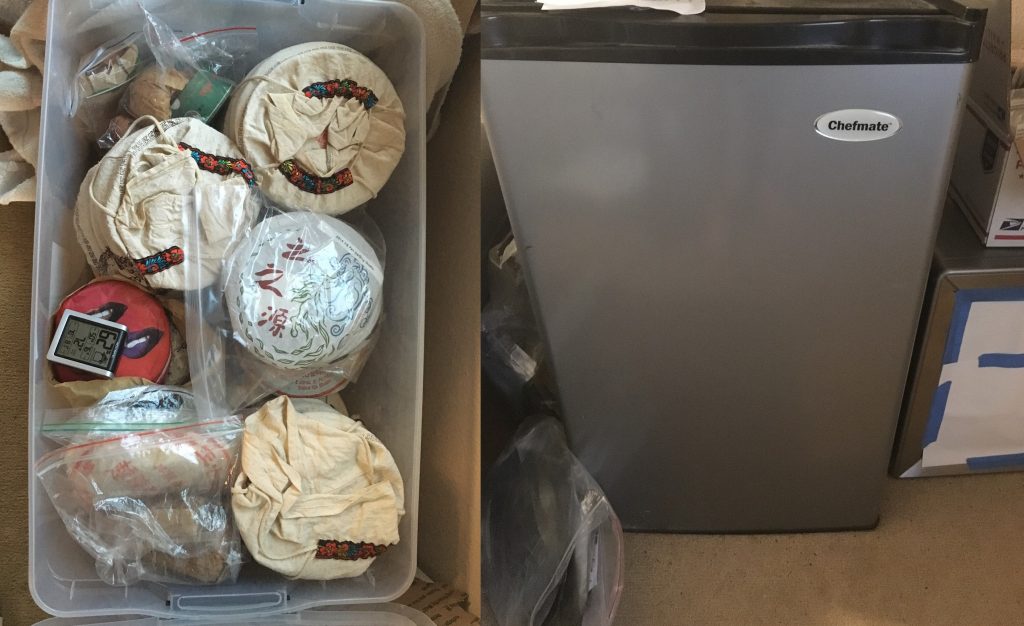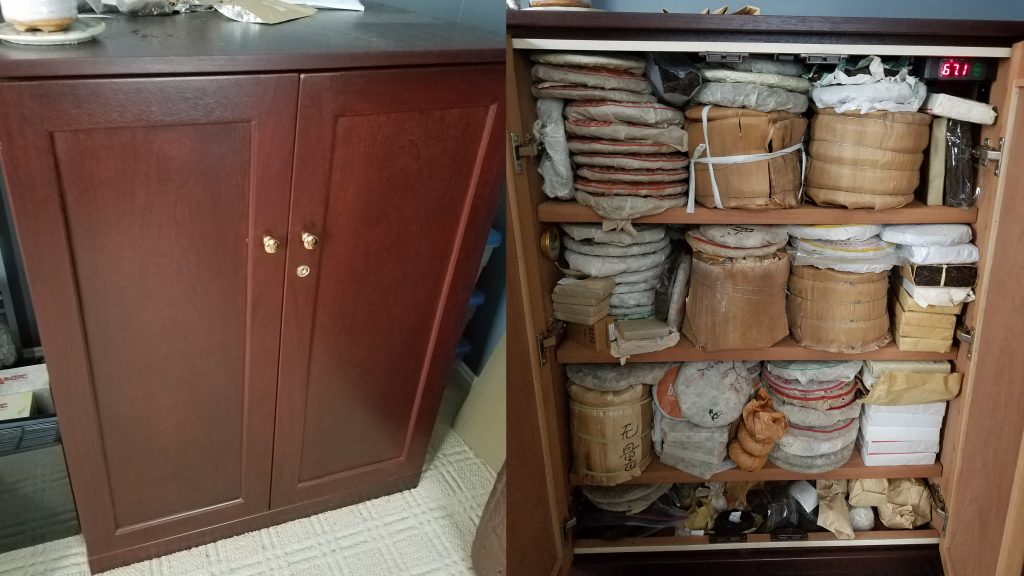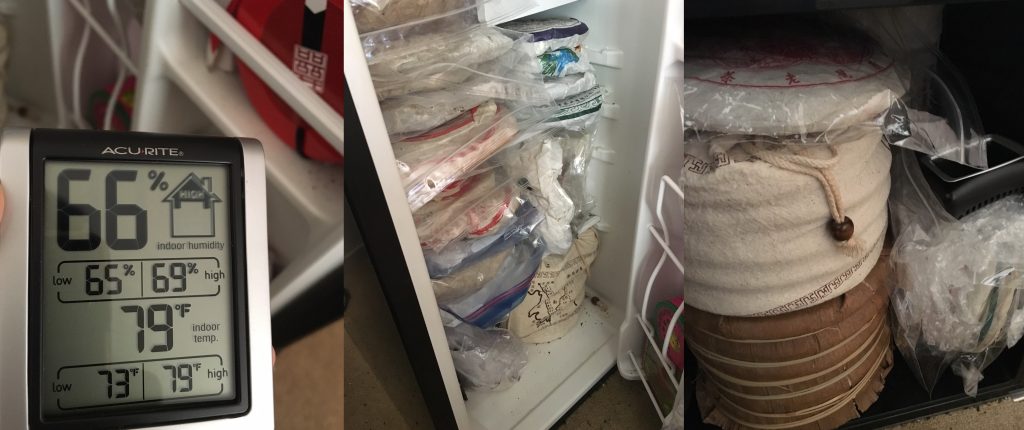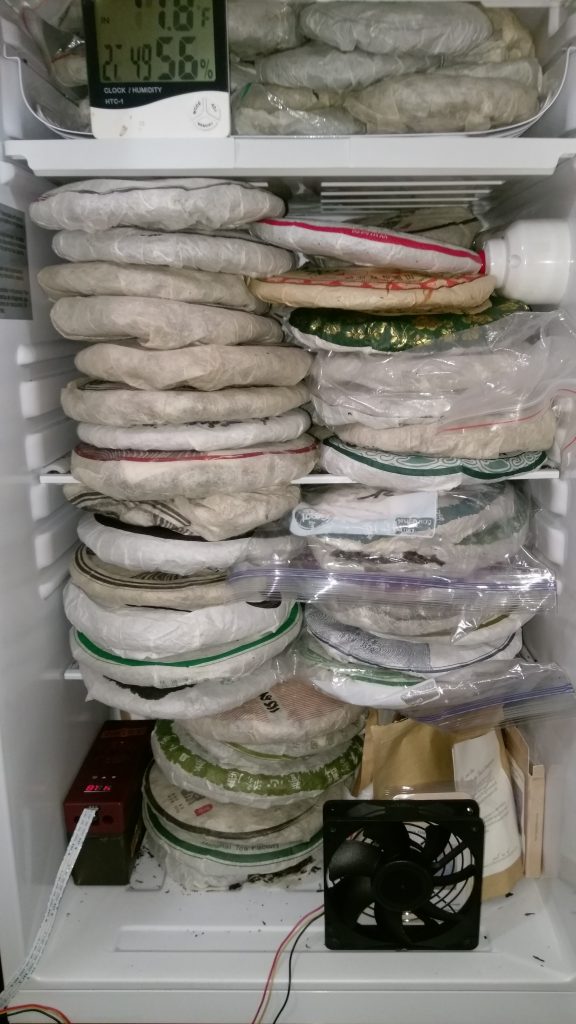The idea of a pumidor is simple. Create an enclosed space where conditions like relative humidity can be manipulated to better maintain and age pu’erh. In the west, this usually means creating an environment where the humidity is higher than the ambient conditions. Much of the western hemisphere west is a cold, and dry relative to pu-hotspots in east Asia. If Kunming is dry compared with places that pu’erh was traditionally exported and stored at, then a good chunk of the US is the desert. With the risk of the tea drying out or simply not evolving or maturing, it is no surprise that the western pu’erh world is filled with people trying to create artificial ways of aging. One such way is the pumidor, a riff on humidor, an airtight device for aging cigars.

The Basics
The two main variables for aging pu’erh are temperature and RH. Temperature is usually the easier variable to manage. People will usually seek temperatures between 65-75, which happily enough is a pretty normal ~room temperature. Some areas will get warmer, but that’s usually not a big concern as pu’erh spends lots of time aging in areas where the temperature is frequently in the 80s or 90s.
The trickier part is the humidity. Much of the west is very dry. This is accomplished by adding some form of humidity.
Inside vs. Outside (temperature and humidity)
You can research the temperature and RH in your area, but what you really need to know are the temperature and humidity in the area where you’ll be storing your pu’erh.. Buy a hygrometer, calibrate it, and start taking measurements for potential areas within your living space. Odds are, they dramatically differ from the weather outside. Things like air conditioning or the heater will effect the inside RH and should be factored into your ultimate decision making.
Choosing a Box: Design Decisions
One of the most important decisions is deciding what you’re going to store your pu’erh in. Here’s a list of options and considerations:
Options:
- Fridge (mini or larger)/Wine Cooler (unplugged)
- Plastic Bin
- Cabinet
- Wood Box
A cardboard box is also a popular solution, but it’s more porous than these others and wouldn’t really qualify as a pumidor for drier conditions.
Size & Tea:Space Density
Picking the right size container can be a challenge. Generally your goal is to maximize the amount of tea to space. Once your container has been loaded with tea, the humidity levels will likely settle at a different point (usually higher) than the natural humidity outside the pumidor. Having a high tea density is helpful in raising the humidity without having to resort to artificial means, i.e. bowls of water or Boveda packs.
Maximizing the tea:space ratio also needs to be balanced with getting a container that has enough empty space to grow your stash to the desired size.

How Porous (Airtight vs. Non-Airtight) & Airflow
Humidor’s are usually airtight, but there’s a lot of different opinions on how much airflow is necessary. While a lot of the Chinese literature talks about the importance of pu’erh being well ventilated this is very misleading to western pu’erh drinkers whose environmental conditions are totally different. Things like cabinets and wooden boxes may naturally be porous. This may result in a bit of airflow, and will also cause the humidity to run more closely align with the external conditions. Devices like a fridge or wine cooler are airtight by design and will have less airflow with the outside environment.
Insulation
One concern with cheaping out is cheap/thin plastic is the insulation. Containers like a fridge or wine cooler will have insulated walls and more protection from moisture accumulating on the walls and sides.
Adding Humidity
One reason for having a pumidor is the ability to add water to heighten the humidity from natural conditions. It should also be noted that by simply having a high density of tea to space in a pumidor will usually also affect the RH from its natural conditions. There’s a number of options:
- Humidifiers (cigar or other).
- Boveda Packs – Intended for cigar storage and can be recharged.
- Bowls/Cups of Water that are regularly replaced.
Be sure to also think about the water you are using. Are you using tap water? Distilled water?
Odors
Tea picks up odors very easily and this should be a major consideration. If you are using a fridge or plastic bin, make sure it is well cleaned and aired out. This includes new plastic smells.. If you go with wood, you’ll also want to research it well to ensure that the wood doesn’t emit unwanted odors that the tea will absorb.
Sealing Cakes
Another subsection of pu’erh users also seal their cakes within the pumidor. People practicing this technique they will wrap the cake in shrink wrap or place it in a ziplock. The shrink wrap allows a little airflow but also helps to maintain the fragrance of the individual tea. Aging will be slower, but it does better to maintain the aromatics of the cake and can be one additional safety measure against mold.

Maintenance
The best maintenance method is to check your cakes everyday and drink from everything. That’s obviously unrealistic. Here’s a simpler list of ways to check on their pu’erh. It’s probably best to check your pumidor consistently when it is first commissioned for use, especially during seasonal shifts.
Check your Temperature & RH – Keep hygrometers to measure temperature and RH and check on them. RH isn’t the only important parameter and it’s important to make sure temperature is kept at a reasonable level. Keep in mind that the RH may vary throughout your pumidor. Take measurements from different areas in the pumidor. Importantly, calibrate your hygrometers every six months or so. Cheaper ones are often inaccurate and can lead to disasters.
Check Humidification Devices – If these go haywire it’s a potential disaster. Make sure these are working properly. If you are using bowls or cups of water, make sure that mold isn’t growing in them and switch them out more frequently if there is.
Airflow – This is a very contentious topic. Some believe that the tea needs to be aired out time to time and will simply open up their pumidor for 5 minutes every month. Others choose to lightly run fans, especially when it is humid. This can be thought of as a safety measure to help prevent mold. Airflow will help to prevent mold from developing but will also slow down the aging of the cakes and take away from the aromatics.
Rotations – Because conditions can vary throughout the pumidor, some like to rotate their tea to different positions in the pumidor. This way, tea will potentially age more evenly over time.
Further Resources
- Home Storage Pumidor Survey
- Dew Point Calculator
- Mopar’s Pu’erh Storage on Death by Tea
- Storage, My Pumidor [Video]
- New Experiment (Sealing) on Listening to Leaves
- Pumidor Project on Listening to Leaves


Leave a Reply